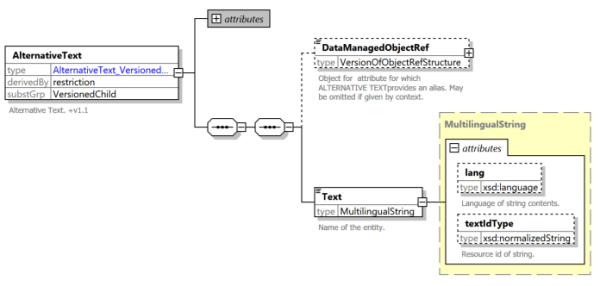FAQ: Difference between revisions
No edit summary |
|||
| Line 38: | Line 38: | ||
== MultilingualString" in NeTex and the management of the translations == | == MultilingualString" in NeTex and the management of the translations == | ||
There are a lot of MultilingualString in NeTEx. All implementions use them. It may be slightly different depending on the language (Java, C/C++, Ruby, Go, Python, etc.) and also on the use case (e.g. there are translations available to be used). | |||
Furthermore, for translations, AlternativeTexts are expected to be used (they do contain MultilingualString but also some more information as presented in the following schema). | |||
[[File:MultilingualString.png|left|frameless|600x600px]] | |||
Also note that an object can have multiple names (not translations but different possible naming): in such case AlternativeNames should be considered. | |||
An xml example '''(EPIP example file),''' where MultilingualString attributes ('''lang''') are used is available in the DATA4PT [https://data4pt-project.eu/knowledge-database/ knowledge database]. | |||
To check your data sets, you may use '''EPIP adapted XML-schema.''' The graphic documentation of the EPIP NeTEx XSD, including MultilingualString description is available [https://data4pt.org/NeTEx/GraphicKit/Documention_of_XSD_for_EPIP.html here] . | |||
Generally, NeTEx example files can be found in the main [https://github.com/NeTEx-CEN/NeTEx/ github repository] , while also other databases with examples are available, (e.g. from [https://enturas.atlassian.net/wiki/spaces/PUBLIC/pages/728891505/NeTEx+examples+catalogue ENTUR]) . | |||
Revision as of 16:26, 28 October 2021
Handling VehicleType in the European Passenger Information Profile
Question 1: Is it correct to include the data category VehicleType in the TimetableFrame as in the NX-PI-01_LU_NAP_LINE_AVL-AVL-91_20210113.xml EPIP example file?
- This example file is available for download under https://data4pt-project.eu/knowledge-database/guidelines/, it includes the data category VehicleType.
Answer 1: Yes, the European Passenger Information Profile, CEN/TS 16614-4:2020,(EPIP) states that the data category VehicleType can be provided in the TimetableFrame. See table 131 – TypeOfFrame: EU_PI_TIMETABLE in the documentation.
Question 2: Are there other possibilities where to define the vehicle type?
Answer 2: Yes, the European Passenger Information Profile, CEN/TS 16614-4:2020,(EPIP) actually also allows, as an option, that the data category VehicleType is instead provided in the ResourceFrame. See table Table 127 – TypeOfFrame: EU_PI_COMMON in the documentation. This second option is now (2021-02-24) also supported in the set of XSD-files available for download from the project website.
How do you create C# classes from the NeTEx XSD?
Answer: It is possible to create C# classes in different ways.
There are many tools out there, but for instance, you could use the Microsoft xsd.exe tool or the mganss/XMLSchemaClassGenerator tool available on Github at https://github.com/mganss/XmlSchemaClassGenerator
Currently there are some issues if you try to use the official NeTEx XSD as a starting point with either of these tools.
However, the above-mentioned tools work fine if you use them together with an adapted set of XSD-files available from Data4PT. The file set is designed to be compatible with the official NeTEx XSD and to cover many important use cases. It does however not cover all use cases possible with the official schema. There is an interactive graphical presentation of the adapted and reduced XSD available at https://data4pt.org/NeTEx/GraphicKit/Documention_of_reduced_XSD.html
If you wish to try out this reduced XSD, you can download it at https://data4pt.org/NeTEx/GraphicKit/XSD_reduced.zip
The work steps if you are using the Microsoft tool are:
- Get the zipped XSD. Extract the ZIP to a folder.
- Make sure that you have a recent version of the xsd.exe. It is part of the .NET Framework Developer Pack and can be downloaded from https://dotnet.microsoft.com/download/dotnet-framework
- Install the developer pack. The xsd.exe will be placed in a folder with a path similar to C:\Program Files (x86)\Microsoft SDKs\Windows\v10.0A\bin\NETFX 4.8 Tools
- Open a command prompt in the same folder as where the NeTEx_publication_reduced-NoConstraint.xsd resides.
- Execute the following command (you may have to adapt the path to xsd.exe): "C:\Program Files (x86)\Microsoft SDKs\Windows\v10.0A\bin\NETFX 4.8 Tools\xsd.exe" /c /language:C# gml_combo_v3_2_1_simplified.xsd NeTEx_publication_reduced-NoConstraint.xsd
The work steps if you are using the MGANSS tool are:
- Get the zipped XSD. Extract the ZIP to a folder.
- Download and extract the binary from https://github.com/mganss/XmlSchemaClassGenerator/releases to a separate folder e.g. C:\MGANSS.
- Open a command prompt in the same folder as where the NeTEx_publication_reduced-NoConstraint.xsd resides.
- Execute the following command (you may have to adapt the path to the exe): C:\MGANSS\XmlSchemaClassGenerator.Console.exe NeTEx_publication_reduced-NoConstraint.xsd -n http://www.opengis.net/gml/3.2=gml -v
MultilingualString" in NeTex and the management of the translations
There are a lot of MultilingualString in NeTEx. All implementions use them. It may be slightly different depending on the language (Java, C/C++, Ruby, Go, Python, etc.) and also on the use case (e.g. there are translations available to be used).
Furthermore, for translations, AlternativeTexts are expected to be used (they do contain MultilingualString but also some more information as presented in the following schema).

Also note that an object can have multiple names (not translations but different possible naming): in such case AlternativeNames should be considered.
An xml example (EPIP example file), where MultilingualString attributes (lang) are used is available in the DATA4PT knowledge database.
To check your data sets, you may use EPIP adapted XML-schema. The graphic documentation of the EPIP NeTEx XSD, including MultilingualString description is available here .
Generally, NeTEx example files can be found in the main github repository , while also other databases with examples are available, (e.g. from ENTUR) .